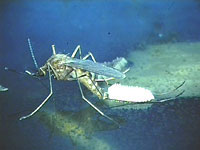Dear Umbra,
Our 50-gallon hot water tank has been converted to a rainwater catchment. Due to the open space around the gutter that feeds rainwater into the tank, it is difficult to seal off the catchment to prevent entry and exit of mosquitoes, and they just love to use the catchment to breed. Can I use something natural to discourage them?
Rebecca
Dearest Rebecca,
The eager Culicidae family, like their fellow insects and some of the rest of us, will stop at nothing when overcome by the need to breed. You might as well face it, they’re addicted to love.

A mosquito lays her eggs.
Photo: Centers for Disease Control.
Some readers may recall our long-ago column about Integrated Pest Management, which emphasized the importance of understanding pest lifecycles. Let us continue in that vein. It is only the female mosquitoes who suck our blood (with their amazing six-part surgical shnozz), seeking sustenance for labor of egg-laying. The males also buzz around our heads, but they are just cruising for chicks. After the lady gets it on, she draws enough blood for her babies, then finds a watery place to lay her clutch.
Like butterflies, mosquitoes undergo metamorphosis. They start as eggs, hatch into larvae, pupate, and finally take to the air as horny adults. The first three stages of mosquito life are aquatic, so the most basic mosquito-control technique is to remove standing water. (In fact, the draining of swamps and wetlands for development is a major reason why the malaria that decimated native tribes in North America after European contact is no longer a major threat in the U.S. But I digress.) A puddle that lasts four hours can become a Culicidae nursery. Diligence must be our watchword.
You have three options. First, you could rig an exclusion device for your catchment system. Have you tried duct-taping mosquito netting around the downspout and letting it cascade like a wedding veil to the top of the tank? Second, you could stock the catchment with fish. Actually, fish probably wouldn’t survive in a water heater, but other readers may find goldfish or mosquito fish useful in their backyard ponds. (However, conscientious readers take note: Mosquito fish may displace native fish if they somehow escape from your backyard pond into the wild world.)

Living larvae.
Photo: Centers for Disease Control.
Finally, if you don’t intend to drink the water from your catchment, you can try using Bacillus thuringiensis, a naturally occurring bacterium. Certain insect larvae eat Bt, which is too bad for them, because it damages the lining of their guts and kills them. In short, it is a disgusting but vital component of organic pest management. Bt has been used for decades by organic farmers to control caterpillars and other larval pests; it recently gained infamy for its inclusion in genetically modified (GM) corn. The Bt in GM corn has been altered in such a way as to kill both pesky and beneficial insects, but the Bt available to you as a gardener will not harm monarch butterflies and other friendly bugs. You can put Bt into your catchment tank in the form of dissolving discs, available through Peaceful Valley Farm Supply. As mentioned above, you shouldn’t drink the water — or rub it into your mucus membranes — but you can feel safe using it to water plants, as it is approved as an organic pesticide right up to harvest.
If poisoning the love-children of innocent insects breaks your heart, you could get a little pond skimmer from the fishing store and just scoop the little buggers out of the tank. Please take some time to admire the mosquito larvae, which swim upside down in a jerky, mermaid-like motion and have a nifty little snorkel on their tail. Nature. It’s amazing.
Love bites,
Umbra

